The AirGradient Open Air Outdoor Air Quality Monitor (O-1PST Kit, PCB Version 1.3)
The AirGradient Open Air Outdoor Air Quality Monitor (O-1PST Kit, PCB Version 1.3)
Introduction
These build instructions are for the AirGradient Open Air Outdoor monitor model O-1PST. If you have a different version, e.g. the O-1PP model, please find your correct build instructions in this overview.
The AirGradient Open Air Outdoor Monitor measures PM2.5, CO2, TVOC, NOx, temperature and humidity. These measures can be sent to a server (e.g. the AirGradient dashboard and map or any other cloud backend) for data logging. The monitor is fully open-hardware / open-source. Schematics, Ki-Cad files, enclosure step files etc. are all freely available.
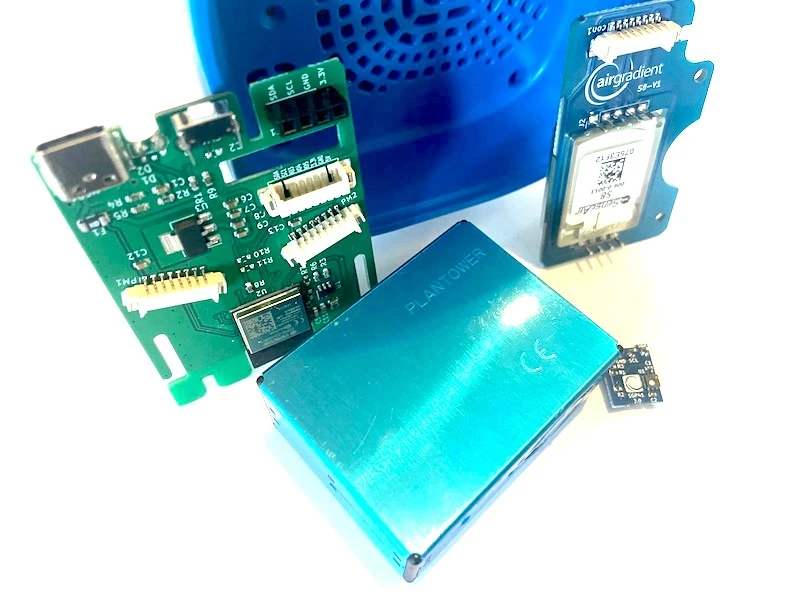
You can purchase the kit with all components from our Online Store which includes the plastic injected enclosure that looks really nice. We ship world-wide.
Skills And Equipment Required
For this project you should be familiar with the following:
| Skill | Description |
|---|---|
| Computer | A Linux, Mac, or Windows computer with the Arduino IDE installed to flash the software onto the microcontroller. You can also flash the software directly from the browser (recommended). |
| Screwdriver | You need a torx (T6) screwdriver which is included in the kit. |
Components
Below is the list of components that you will receive with the pre-soldered kit:
| Component | Details |
|---|---|
| AirGradient Open Air PCB | with ESP-32-C3 |
| Plantower PMS5003T | PM Sensor |
| SenseAir S8 module | NDIR CO2 Sensor |
| SGP41 module | TVOC/NOx Sensor |
| 2x JST 8 cross-over cable | for connecting PM and CO2 sensors |
| USB-C cable | 4 meter long (for flashing and power) |
| Enclosure | UV-resistant injection molded ASA plastic |
| 2x Small Screws for SenseAir S8 module | M1.8x11 (Torx T6) |
| 4x Screws for enclosure | M1.8x11 (Torx T6) |
| Screwdriver | Torx T6 |
Assembly
The assembly of the unit is simple as no soldering is required.
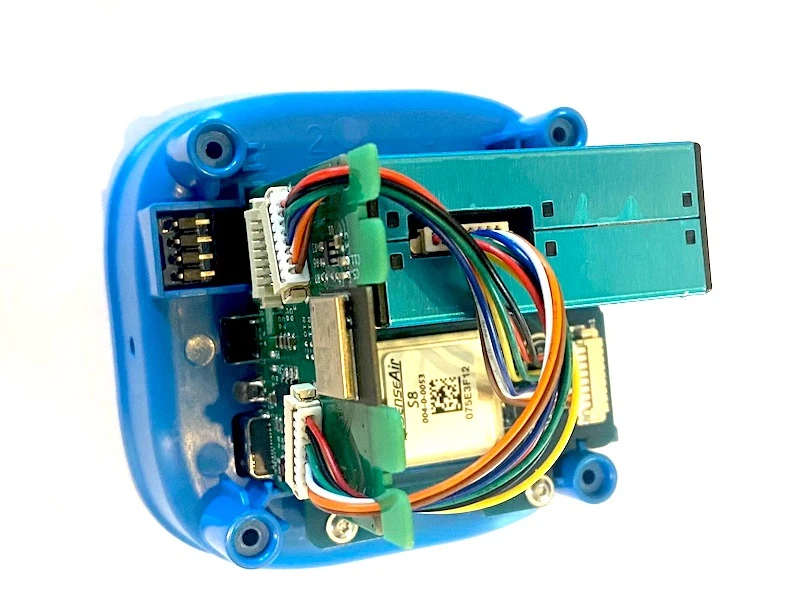
We recommend you start in the following order:
Connect the SGP41 sensor module
Plug in the SGP41 TVOC/NOx module into the pin holder. Ensure that the module faces outwards.
Please note that there is a small gap between the socket and the module. This is totally fine and does not impact the performance of the sensor.
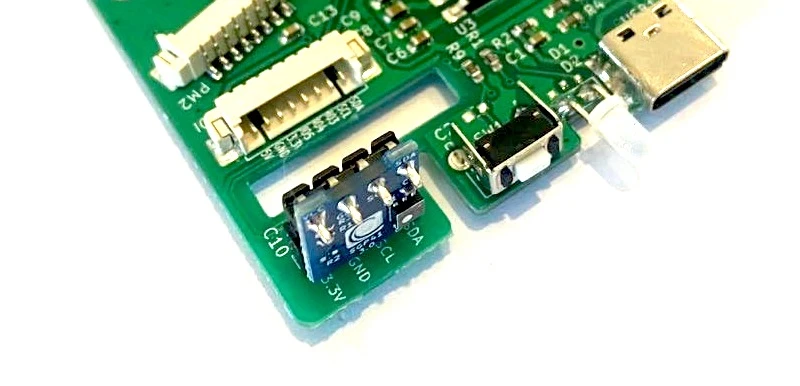
Connect the S8 sensor module
Screw in the S8 module using the 2 smaller screws supplied and connect the cable. Use the longer cable of the two supplied with the kit.
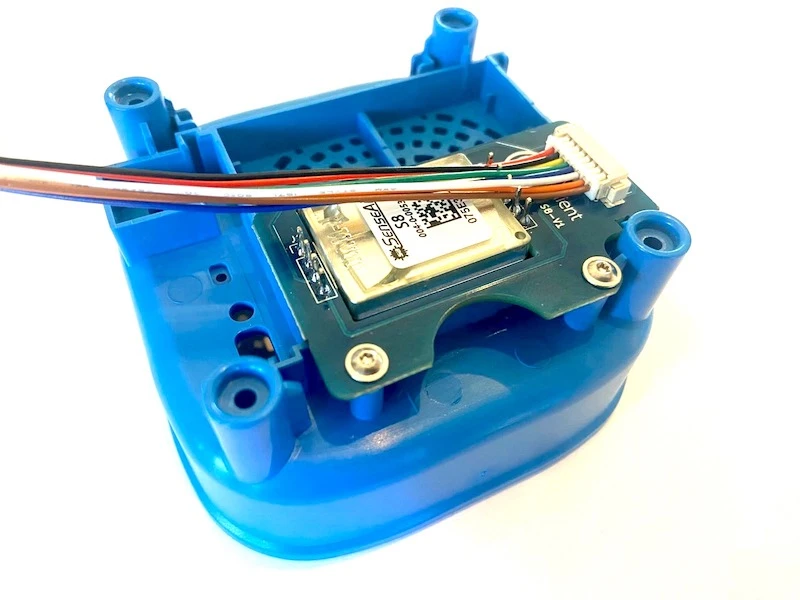
Connect the PM Cables
Connect the PM cable to the PM sensor. Make sure you put the cable into the PM sensor in the right way.
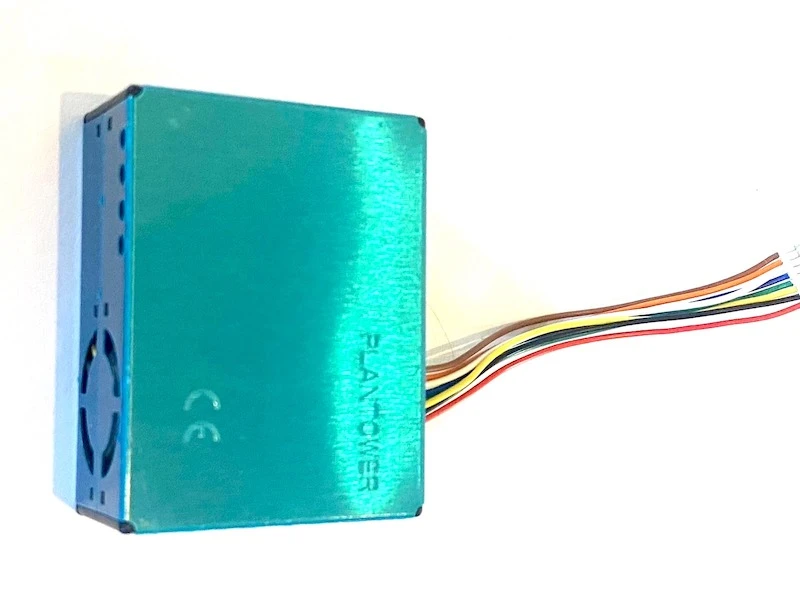
Placement of the parts inside the enclosure
Now you need to connect the two cables to the board. Connect the longer cable from the CO2 module to the connector labelled “PM2” and the shorter cable from the PM Sensor to the connector labelled “PM1”. Then feed the cables through the feeder holes on the side of the PCB and put the board and PM sensor into the bottom part of the enclosure:

Closing the enclosure
After you have made sure that the cables are aligned correctly, the PCB is 100% upright and that all parts are fitted in correctly, carefully slide the top part onto the assembly. As soon as you feel there is some resistance from components or cables inside the enclosure, do not force it but lift up the top part and check again if the PCB is upright and the cables not interfere with the plastic rifts.
Once the two parts slide together smoothly, turn the complete assembly around and use the four longer screws to put it together.
Power Supply
The power supply is not included in the kit. Please get a standard 5v, 2A power supply. If you use the power supply outdoors, please make sure it is suitable for outdoor use and does not pose a safety risk.
Software
The kit already comes with the software flashed to connect it to the AirGradient dashboard and map. So in case you do not want to change the firmware and connect it to a different server, you can skip this software part and continue with connecting to the Dashboard and Map part.
Direct Flashing Through The Browser
Version 3.3.8 Release |
Older firmware versions and change logs are available here.
Flashing Instructions
Important. Please follow these steps for flashing only. If you only want to see debug messages and logs of the monitor see the instructions for logging:
- Push the button on the PCB and keep it pushed
- Plug in the USB C cable
- Release the button. If you do not do this, the board will not get into the flash mode.
- Press the blue button above
- Select the serial port your monitor is connected to. It is typically called “USB JTAG / Serial Debug”
- Follow the instructions for flashing
- After the flashing is complete, restart the monitor by unplugging the USB C cable (and plugging it back in)
Logging Instructions
Follow below to see debug messages and logs of the monitor:
- Plug in the USB C cable
- Press the blue button above
- Select the serial port your monitor is connected to. It is typically called “USB JTAG / Serial Debug”
- Click on “Logs & Console”
- Click on “Reset Device” to reboot the monitor
Now you can see the debug messages and also identify the serial number.
BOOT Error During Flashing
In case you get an error called “Failed to initialize. Try resetting your device or holding the BOOT button while clicking INSTALL” during the flashing, you need to put the board into a special boot mode. To do this please follow below steps:
- Push the button labelled on the PCB and keep it pushed. This is also the button behind the small hole next to the USB connector at the bottom of the enclosure. So if you don't want to open the enclosure you can also press it with a small pin through the enclosure.
- Plug in the USB C cable
- Release the button. If you do not do this, the board will not get into the flash mode.
- Press the blue button above to flash
- Select the serial port your monitor is connected to. It is typically called “USB JTAG / Serial Debug”
- Follow the instructions for flashing. In case you want to delete previously saved WiFi passwords on the device, check the box 'Erase the Device'.
- After the flashing is complete, restart the monitor by unplugging the USB C cable (and plugging it back in)
AirGradient Dashboard & Map
The easiest way to start using AirGradient Dashboard and Map with your monitor is our onboarding wizard:
It will first guide you through the account creation (or login if you already have an AirGradient account). Then you will be able to set up your place. A place is where you can connect several monitors to. For example your house, school or office. Each place has its own dashboard.
Once you have your account and place setup, you will be able to connect your monitor to the WiFi and add it to your place’s dashboard by following the wizard instructions.
When the monitor is connected and “Share data with the AirGradient API, AirGradient Map and 3rd parties” is activated, your monitor will appear on the AirGradient Map.
If you have some problems, please check out our knowledge base articles.
Connecting to WiFi
If you only want to connect your monitor to WiFi without using AirGradient Dashboard, please follow the WiFi Connection instructions.
Flashing With The Arduino Software
If you want to make changes to the code, you can do so with the Arduino software by following below steps.
a) Install the latest version of the_ Arduino Software on your computer.
b) Enable the ESP32 C3 board. You need to enable the MCU in the Arduino IDE by following these steps:
- Start Arduino and open the Preferences window.
- Enter https://raw.githubusercontent.com/espressif/arduino-esp32/gh-pages/package_esp32_dev_index.json into Additional Board Manager URLs field.
- Open Boards Manager from Tools > Board menu and find the ESP32 platform.
- Select the latest version you need from a drop-down box.
- Click the install button.
- Select the Lolin C3 Mini board from Tools > Board menu after installation.
Flashing Of The AirGradient Firmware
Once you have the Arduino Software setup for the C3 Mini, you can flash it with the AirGradient firmware.
| Step | Description |
|---|---|
| 1 | Go to Tools, Manage Libraries, and then search for AirGradient and install the AirGradient library. Make sure you install the Arduino AirGradient library version 2.4.3 or higher. |
| 2 | Once it is installed, go to File, Example, AirGradient and select the OneOpenAir.ino code |
| 3 | Read the instructions on top of the example code |
| 4 | Then edit/flash this code |
Mounting
For accurate readings and optimal performance of your AirGradient Open Air Outdoor monitor, it is crucial to mount the device correctly.
Please follow the detailed mounting instructions to ensure your monitor is securely installed and functioning properly.
CC BY-SA 4.0 Attribution-ShareAlike 4.0 International
This work is licensed under CC BY-SA 4.0.
This license requires that reusers give credit to the creator. If you remix, transform, or build upon the material, you must distribute your contributions under the same license as the original.
Copyright AirGradient Co. Ltd.